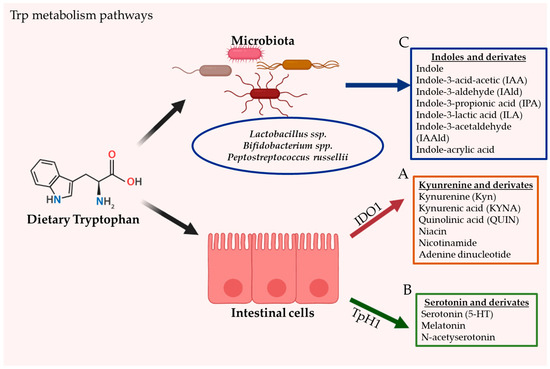Tryptophan (Trp) is an essential aromatic amino acid that is acquired exclusively through dietary intake in humans (since Trp is not produced by animal cells). Common sources of dietary Trp are fish, poultry, cereals, and dairy foods. The World Health Organization advises an intake of 4 mg of Trp/kg/day. Trp is a precursor of several microbial and host metabolites, including several molecules such as serotonin, melatonin, nicotinamide and vitamin B3. The intestine is a prime location of Trp metabolism. Three main metabolic pathways can process dietary Trp: (i) the kynurenine pathway (KP) via indoleamine 2,3-dioxygenase (IDO)1, mainly occurring in both immune and epithelial cells, (ii) the serotonin (5-hydroxytryptamine [5-HT]) pathway via Trp hydroxylase 1 (TpH1) in enterochromaffin cells, and finally (iii) the direct conversion of Trp by the intestinal microbiota into several.
- Dietary tryptophan
- kynurenine pathway
- Serotonin production pathway
- Indoles and derivates
- IDO1
- TpH1
- Microbiota

Figure 1. The gastrointestinal tract is the principal location of tryptophan (Trp) metabolism. In humans, Trp is acquired exclusively through dietary intake. Dietary Trp can be processed by three main metabolism routes: (A) the kynurenine pathway (KP), which mainly occurs in both immune and epithelial cells via IDO1, leading to several kynurenine metabolites (KYNs) including ligands for AhR (B) the serotonin production pathway, taking place in enterochromaffin cells (subtype of intestinal epithelial cells) and via TpH1, and finally (C) the direct conversion of Trp by the gut microbiota into several Indoles and derivates, including ligands of the AhR.
